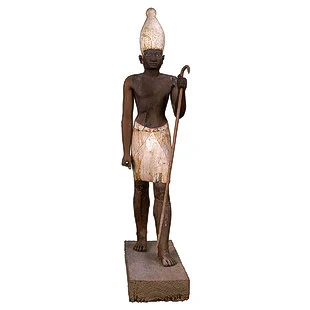King Senusert the First was the second king of the Twelfth Dynasty. His reign was during a time when literature and craftsmanship were at their peak. It was a period of affluence and a remarkable time for mineral wealth, gold, and the fine jewelry produced with this abundance.
Considerable efforts were made to procure amethyst, turquoise, and copper for both jewelry and sculptures. But it was also a time of great stability and development.
Senusert the First built his pyramid and funerary temple at Lisht, near Faiyum. This was the new residence that he made after Thebes was abandoned. Many statues of him were found there.
He built an elegant bark-station, or shrine, for Amun-Re at Karnak. It depicts marvelous reliefs showing the king's relationships with the Theban deities.
Kom Ushim, near ancient Karanis, boasts of a small museum. Many artifacts found within the Fayium region are housed in this museum. Displays include delicate glassware and pottery, as well as female heads that are thought to have been used to model hairstyles.
The museum also exhibits two of the famous "Faiyum Portraits" (others can be seen in the Cairo Museum). Toward the end of the Greco-Roman period, these personal portraits were painted on wood or linen and were used to cover the face of the mummy. The faces are always serious and have very large dark and staring eyes. They are often portrayed in the prime of life.
The portraits, which greatly influenced Coptic art in Egypt, provide a link between the art of the ancient Egyptians and later portraiture during the Middle Ages.
Considerable efforts were made to procure amethyst, turquoise, and copper for both jewelry and sculptures. But it was also a time of great stability and development.
Senusert the First built his pyramid and funerary temple at Lisht, near Faiyum. This was the new residence that he made after Thebes was abandoned. Many statues of him were found there.
He built an elegant bark-station, or shrine, for Amun-Re at Karnak. It depicts marvelous reliefs showing the king's relationships with the Theban deities.
Faiyum is the earliest known agricultural area in the world, located in the western desert, about 90 kilometers or 56 miles southwest of Cairo.
This oasis was developed by the kings of the Middle Kingdom who started great irrigation and cultivation projects at this site. Its water level was 85 meters or 279 feet higher than today and the Nile regularly flooded through the low mountains.
This oasis was developed by the kings of the Middle Kingdom who started great irrigation and cultivation projects at this site. Its water level was 85 meters or 279 feet higher than today and the Nile regularly flooded through the low mountains.
The museum also exhibits two of the famous "Faiyum Portraits" (others can be seen in the Cairo Museum). Toward the end of the Greco-Roman period, these personal portraits were painted on wood or linen and were used to cover the face of the mummy. The faces are always serious and have very large dark and staring eyes. They are often portrayed in the prime of life.
The portraits, which greatly influenced Coptic art in Egypt, provide a link between the art of the ancient Egyptians and later portraiture during the Middle Ages.


